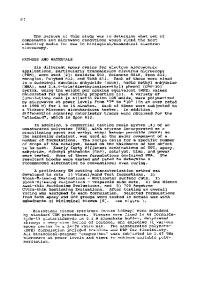Dynamic Covalent Polymerization of Chalcogenide Hybrid Inorganic/Organic Polymer Resins with Norbornenyl Comonomers
- PDF / 1,181,872 Bytes
- 7 Pages / 595 x 842 pts (A4) Page_size
- 8 Downloads / 255 Views
Article
DOI 10.1007/s13233-020-8136-7
www.springer.com/13233 pISSN 1598-5032 eISSN 2092-7673
Dynamic Covalent Polymerization of Chalcogenide Hybrid Inorganic/ Organic Polymer Resins with Norbornenyl Comonomers Minho Kwon1 Hongchan Lee1 Seo-Hui Lee2 Heung Bae Jeon2 Min-Cheol Oh3 Jeffrey Pyun*,4 Hyun-jong Paik*,1
1
Department of Polymer Science, Pusan National University, Pusan 46241, Korea Department of Chemistry, Kwangwoon University, Seoul 01897, Korea 3 Department of Electronics Engineering, Pusan National University, Pusan 46241, Korea 4 Department of Chemistry & Biochemistry, University of Arizona, Tucson, Arizona 2
Received March 6, 2020 / Revised June 2, 2020 / Accepted June 20, 2020
Abstract: Elemental sulfur (S8) is an inexpensive chemical feedstock for polymeric materials but has the disadvantages of poor solubility in organic media and inferior physical properties in the elemental form. We report on the preparation of organosulfur chalcogenide hybrid inorganic/organic polymer (CHIPs) based on bifunctional norbornene comonomers using dynamic covalent polymerization (DCP). A poly(sulfurrandom-styrene) (p(S-r-Sty)) resin was utilized to address the limited solubility/ miscibility of norbornene-containing comonomers in liquid sulfur. This report demonstrated the ability to expand the scope of organic comonomers to prepare organosulfur CHIPs from elemenatal sulfur using a combination of inverse vulcanization and dynamic covalent polymerization. Keywords: sulfur polymerization, dynamic covalent polymerization, inverse vulcanization, norbornenes, norbornyl comonomers.
1. Introduction The elemental sulfur (S8) as abundantly available by-product from the refining of oil and gas has drawn significant attention for value additions in the form utilization as a feedstock for polymeric materials.1 However, the use of S8 as a reagent for chemical synthesis and polymer chemistry is problematic due to the limited solubility and miscibility of elemental sulfur with the vast majority of organic chemical reagents/monomers, which arises from the highly crystalline nature of S8. Furthermore, S8 also intrinsically shows poor physical properties (e.g., low mechanical strength, brittleness), which limits the processing of polymers with elemental sulfur via classical blending approaches.2 However, S8 is capable of chemical modification, since high temperature homolytic thermolysis of S-S bonds has long been known to undergo equilibrium polymerization leading to higher molar mass polymeric sulfur that readily depolymerizes back to monomer. Alternatively, Penzcek et al. were the first to report on anionic ring-opening polymerization of S8 with thiiranes to prepare linear organopolysulfide based polymers. However, the lower rate constants of propagation (kp) and the depolymerization of propagating polysulfides have historically complicated the use of sulfur for polymerization, which has further limited the scope of materiAcknowledgments: This research was supported by PNU-RENovation (2018-2019) and the Industrial Strategic Te
Data Loading...











